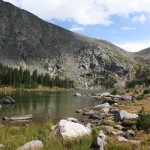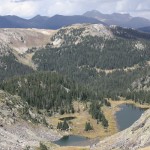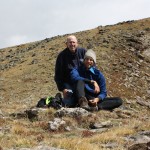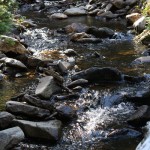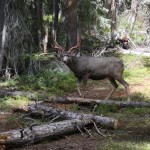Post 2 of 2: A few weeks ago I took a backpacking trip in Rocky Mountain National Park with my son, my return to a particular high country campsite after 40 years. Here’s the second half of my notes, edited to seem even more insightful than the first.
THURSDAY, Sep 6
Made Timber Lake today, a “long, hard slog.” Quite a few day trippers up here, mostly fishers. One group of 3 with day packs, shorts and sleeveless shirts just left for the trailhead nearly 5 miles away. It’s 5pm, with maybe 3 hours of light left. Good luck with that. I’d hate to be stumbling around on the trail in the dark.
.
Cooking has been a challenge. Fires are prohibited and only stoves allowed. This means balancing cooking equipment, eating utensils, ingredients, and cooked food on rocks, logs, or the ground. So I was delighted to find the only flat spot in the entire park at Rockslide Campsite: the stump of a dead pine felled by a jack with a Euclidean sensibility. Even better than merely flat, the cut surface is within 1-2 degrees of perfectly level, as the water in my bottle reveals.
A fisher coming down from the lake alerted us to moose ahead. Minutes later we saw them, a cow and her calf, both aware of us, alert, but unwilling to move from their creekside forage 40 yards away. We paid homage and moved on.
Timber Lake is smaller than I remembered, and comprised of three distinct basins, but still cold and still clear.
Rain during the night, light rain. Cozy.
FRIDAY, Sep 7
Cold, clammy morning. Clouds began to break apart about 11, allowing a trip up Mt. Ida. Rain kept menacing, however, with the temp alternating between 50 and 70 degrees, depending on the sun. Got within a few hundred feet of the 12,800-foot summit, when hail and approaching dark clouds hung with streamers of rain convinced us to turn back.
.
Nick came face-to-face with the moose cow and calf on the return trip, maybe within 20 feet. The cow quietly turned away, and after a second the calf followed. By the time we covered the 20 feet, they were out of sight.
Hail continued from the lake to the Rockslide Campsite, turning to rain just as we zipped up the tent. Sun 15 minutes later, with rain 15 minutes after that, lasting an hour or so. Ate dinner early, not knowing how long the dry spell would last.
SATURDAY, Sep 8
Hiked out with nearly the same loads we carried in (I overestimated our food needs). The sunny, cool morning was a relief, considering the five miles of lunges my legs suffered on the way down.
.
An excellent adventure, sweaty at times but always relaxed. It’s comforting to know that hard physical labor is still possible at my age, although it helps to have a good companion to set the pace and lend a hand over the tougher spots.
The trail, the lake, the mountain have all changed a great deal in 40 years, but that’s more a statement of the weakness of memory than the power of nature. The two trips could not have been more rewarding in their different ways. I’ll cherish them both, the one when I wondered what I was going to make of myself and the one when I knew and wondered if it was too late to do better.

